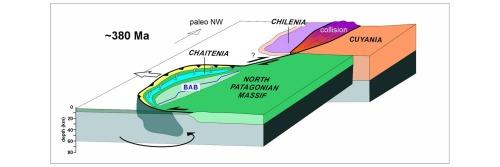Birth, life and death of the Devonian Chaitenia back-arc along the Southwestern Gondwanan margin (southern Chile)
IF 7.2
1区 地球科学
Q1 GEOSCIENCES, MULTIDISCIPLINARY
引用次数: 0
Abstract
The late Paleozoic evolution of SW Gondwana at the current latitudes of 38-40°S involved three different blocks (Chilenia, Chaitenia and North Patagonia), whose origin and tectonic evolution is debated, making paleogeographic reconstructions challenging. Here we address this issue by constraining the tectonic setting and the metamorphic evolution of mafic rocks outcropping in three sectors (Guzmán at 38°33′S, San Carlos at 40°54′S, Los Pabilos at 40°57′S) of the late Paleozoic basal accretionary complex of the Chilean Coastal Cordillera. The geochemical results suggest that their protoliths originated in a back-arc lithosphere correlating with the Chaitenia back-arc while our P–T–t paths reconstructions show that this basin closed diachronically. In the southern part of the basin, the peak metamorphic conditions of ∼ 450 °C and 1.4–1.6 GPa estimated for the San Carlos blueschists are interpreted as representing a cold thermal configuration for the subduction already reached at 335 Ma (in situ 40Ar/39Ar on phengite). Comparatively, in its northern part, the Guzmán garnet-bearing amphibolites still followed at the same time a warmer counterclockwise P–T path, interpreted as the initiation of the intra-back-arc subduction, reaching metamorphic peak conditions of ∼ 650 °C and 1–1.2 GPa. The amphibolites further cooled down to 500 °C at 311–299 Ma (in situ 40Ar/39Ar on hornblende) and underwent a hydration event under conditions of 480–520 °C and 0.8–1.1 GPa at 277–270 Ma (in situ 40Ar/39Ar on actinolite). Our results suggest that the Chaitenia oceanic arc and back-arc system extended about 300 km further north than previously thought, up to the present 38°S latitude. Moreover, we propose that the opening of the Chaitenia back-arc is closely linked to along-strike transition from collision of the Chilenia terrane at the northwest to normal subduction beneath the North Patagonian margin at the southeast, triggering slab curving, tearing and roll-back.

冈瓦南西南缘(智利南部)泥盆纪柴氏后弧的生灭
目前南纬38 ~ 40°S的西南冈瓦纳晚古生代演化涉及三个不同的地块(Chilenia、Chaitenia和North Patagonia),它们的起源和构造演化存在争议,这给古地理重建带来了挑战。本文通过对智利沿海科迪勒拉晚古生代基底增生复岩三个剖面(Guzmán在38°33′s, San Carlos在40°54′s, Los Pabilos在40°57′s)裸露的基性岩的构造背景和变质演化进行了研究。地球化学结果表明它们的原岩起源于与柴氏期弧后相对应的弧后岩石圈,而P-T-t路径重建表明该盆地是历时封闭的。在盆地南部,估计圣卡洛斯蓝片岩的峰值变质条件为 ~ 450 ~ °C和1.4 ~ 1.6 GPa,被解释为代表了俯冲已经达到335 Ma(在云母岩上的40ar /39Ar)的冷-热配置。相比之下,在其北部,Guzmán含石榴石角闪岩同时仍然遵循一个更温暖的逆时针P-T路径,这被解释为弧后俯冲的开始,达到 ~ 650 °C和1-1.2 GPa的变质峰值条件。角闪石在311-299 Ma(角闪石上的40ar /39Ar)条件下进一步冷却至500 °C,并在480-520 °C和0.8-1.1 GPa(277-270 Ma)条件下进行水化反应(光闪石上的40ar /39Ar)。我们的研究结果表明,Chaitenia洋弧和弧后系统比先前认为的向北延伸了约300 km,直到目前的38°S纬。此外,我们认为柴田系弧后的打开与从西北的智利系地体碰撞到东南的北巴塔哥尼亚边缘的正常俯冲的沿走向转变密切相关,引发了板块的弯曲、撕裂和回滚。
本文章由计算机程序翻译,如有差异,请以英文原文为准。
求助全文
约1分钟内获得全文
求助全文
来源期刊

Gondwana Research
地学-地球科学综合
CiteScore
12.90
自引率
6.60%
发文量
298
审稿时长
65 days
期刊介绍:
Gondwana Research (GR) is an International Journal aimed to promote high quality research publications on all topics related to solid Earth, particularly with reference to the origin and evolution of continents, continental assemblies and their resources. GR is an "all earth science" journal with no restrictions on geological time, terrane or theme and covers a wide spectrum of topics in geosciences such as geology, geomorphology, palaeontology, structure, petrology, geochemistry, stable isotopes, geochronology, economic geology, exploration geology, engineering geology, geophysics, and environmental geology among other themes, and provides an appropriate forum to integrate studies from different disciplines and different terrains. In addition to regular articles and thematic issues, the journal invites high profile state-of-the-art reviews on thrust area topics for its column, ''GR FOCUS''. Focus articles include short biographies and photographs of the authors. Short articles (within ten printed pages) for rapid publication reporting important discoveries or innovative models of global interest will be considered under the category ''GR LETTERS''.
 求助内容:
求助内容: 应助结果提醒方式:
应助结果提醒方式:


